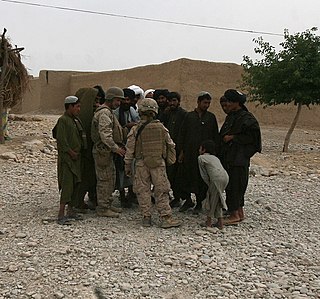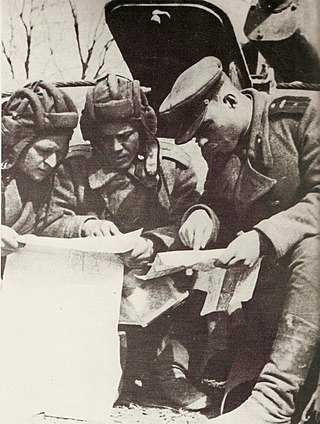Notes
- ↑ Chairman, U.S. Joint Chiefs of Staff, Department of Defense Dictionary of Military and Associated Terms, Joint Publication (JP) 1-02 (Washington, DC: CJCS, April 12, 2001, Amended October 31, 2009), p. 74.
Campaign plan is a plan to achieve an objective, usually of a large-scale over an extended period of time. It usually coordinates many activities and uses of resources involving multiple organizations. A campaign plan could also have subordinate objectives or intermediate milestones and is often broken down by phases. They often begin with an assessment of the situation to put the plan in context. Campaign plans are often created in business marketing, political campaigning and military campaigning.
An example of a military campaign plan is Noble Resolve.
The U.S. Military defines campaign plan as:
A tactic is a conceptual action or short series of actions with the aim of achieving a short-term goal. This action can be implemented as one or more specific tasks. The term is commonly used in business, protest and military contexts, as well as in chess, sports or other competitive activities. The word originated from the Ancient Greek τακτική taktike, meaning art of arrangement.
Military doctrine is the expression of how military forces contribute to campaigns, major operations, battles, and engagements. A military doctrine outlines what military means should be used, how forces should be structured, where forces should be deployed, and the modes of cooperation between types of forces. "Joint doctrine" refers to the doctrines shared and aligned by multinational forces or joint service operations.

Military intelligence is a military discipline that uses information collection and analysis approaches to provide guidance and direction to assist commanders in their decisions. This aim is achieved by providing an assessment of data from a range of sources, directed towards the commanders' mission requirements or responding to questions as part of operational or campaign planning. To provide an analysis, the commander's information requirements are first identified, which are then incorporated into intelligence collection, analysis, and dissemination.

In the field of military theory, the operational level of war represents the level of command that connects the details of tactics with the goals of strategy.
A military campaign is large-scale long-duration significant military strategy plan incorporating a series of interrelated military operations or battles forming a distinct part of a larger conflict often called a war. The term derives from the plain of Campania, a place of annual wartime operations by the armies of the Roman Republic.
Principles of war are rules and guidelines that represent truths in the practice of war and military operations.
Annihilation is a military strategy in which an attacking army seeks to entirely destroy the military capacity of the opposing army. This strategy can be executed in a single planned pivotal battle, called a "battle of annihilation". A successful battle of annihilation is accomplished through the use of tactical surprise, application of overwhelming force at a key point, or other tactics performed immediately before or during the battle.
Targeting is the process of selecting objects or installations to be attacked, taken, or destroyed in warfare. Targeting systematically analyzes and prioritizes targets and matches appropriate lethal and nonlethal actions to those targets to create specific desired effects that achieve the joint force commander's (JFC's) objectives, accounting for operational requirements, capabilities, and the results of previous assessments. The emphasis of targeting is on identifying resources (targets) the enemy can least afford to lose or that provide him with the greatest advantage, then further identifying the subset of those targets that must be acquired and engaged to achieve friendly success. Targeting links the desired effects to actions and tasks.
Strategic communication can mean either communicating a concept, a process, or data that satisfies a long-term strategic goal of an organization by allowing facilitation of advanced planning, or communicating over long distances usually using international telecommunications or dedicated global network assets to coordinate actions and activities of operationally significant commercial, non-commercial and military business or combat and logistic subunits. It can also mean the related function within an organization, which handles internal and external communication processes. Strategic communication can also be used for political warfare.

Psychological operations (PSYOP) are operations to convey selected information and indicators to audiences to influence their motives and objective reasoning, and ultimately the behavior of governments, organizations, groups, and large foreign powers.

Command and control is a "set of organizational and technical attributes and processes ... [that] employs human, physical, and information resources to solve problems and accomplish missions" to achieve the goals of an organization or enterprise, according to a 2015 definition by military scientists Marius Vassiliou, David S. Alberts, and Jonathan R. Agre. The term often refers to a military system.
A decisive victory is a military victory in battle that definitively resolves the objective being fought over, ending one stage of the conflict and beginning another stage. Until a decisive victory is achieved, conflict over the competing objectives will continue.
Effects-based operations (EBO) is a United States military concept that emerged during the Persian Gulf War for the planning and conduct of operations combining military and non-military methods to achieve a particular effect. An effects-based approach to operations was first applied in modern times in the design and execution of the Desert Storm air campaign of 1991. The principal author of the daily attack plans—then Lt Colonel, now retired Lt General David A. Deptula—used an effects-based approach in building the actual Desert Storm air campaign targeting plan. Deptula describes the background, rationale, and provides an example of how an effects-based approach to targeting was conducted in Desert Storm in the publication, "Effects-Based Operations: Change in the Nature of Warfare." The doctrine was developed with an aim of putting desired strategic effects first and then planning from the desired strategic objective back to the possible tactical level actions that could be taken to achieve the desired effect. Contrary to conventional military approaches of force-on-force application that focused on attrition and annihilation, EBO focused on desired outcomes attempting to use a minimum of force. The approach was enabled by advancements in weaponry—particularly stealth and precision weapons—in conjunction with a planning approach based on specific effects rather than absolute destruction. Deptula, speaking at the Gulf War Air Campaign Tenth Anniversary Retrospective, on 17 January 2001 on One Massachusetts Avenue, NW, Washington, DC, defined the goal of EBO; "If we focus on effects, the end of strategy, rather than force-on-force the traditional means to achieve it militarily, that enables us to consider different and perhaps more effective ways to accomplish the same goal quicker than in the past, with fewer resources and most importantly with fewer casualties." Others have postulated that EBO could be interpreted as an emerging understanding that attacking a second-order target may have first order consequences for a variety of objectives, wherein the Commander's intent can be satisfied with a minimum of collateral damage or risk to his own forces.
A military operation plan is a formal plan for military armed forces, their military organizations and units to conduct operations, as drawn up by commanders within the combat operations process in achieving objectives before or during a conflict. Military plans are generally produced in accordance with the military doctrine of the troops involved. Because planning is a valuable exercise for senior military staff, in peacetime nations generally produce plans even for very unlikely hypothetical scenarios.
An offensive is a military operation that seeks through an aggressive projection of armed forces to occupy or recapture territory, gain an objective or achieve some larger strategic, operational, or tactical goal. Another term for an offensive often used by the media is "invasion", or the more general "attack". An offensive is a conduct of combat operations that seek to achieve only some of the objectives of the strategy being pursued in the theatre as a whole. Commonly an offensive is carried out by one or more divisions, numbering between 10 and 30,000 troops as part of a combined arms manoeuvre.

A tactical objective is the immediate short-term desired result of a given activity, task, or mission. Tactical objectives are usually entrusted to the lower positioned management in a three-tier organisation's structure of field or front desk, middle and executive management. While historically the term had been applied to military operations, in the 20th century, it has been increasingly applied in the fields of public safety, such as policing, and fire-fighting, commerce, trade planning, political, and international relations policy.
A strategic military goal is used in strategic military operation plans to define the desired end-state of a war or a campaign. Usually it entails either a strategic change in an enemy's military posture, intentions or ongoing operations, or achieving a strategic victory over the enemy that ends the conflict, although the goal can be set in terms of diplomatic or economic conditions, defined by purely territorial gains, or the evidence that the enemy's will to fight has been broken. Sometimes the strategic goal can be to limit the scope of the conflict.

Civil-military operations or CMO are activities of a military force to minimize civil interference on and maximize civil support for military operations. CMO is conducted in conjunction with combat operations during wartime and becomes a central part of a military campaign in counter-insurgencies. Some militaries have specialized units dedicated to conduct CMO, such as civil affairs forces or form task forces specifically for this purposes, such as a joint civil-military operations task force in the U.S. Military. Also, some militaries have staff sections dedicated to planning and coordinating CMO for their command. CMO is often called civil-military co-operation or CIMIC in NATO operations and civil-military co-ordination in UN operations.
Unity of effort is the state of harmonizing efforts among multiple organizations working towards a similar objective. This prevents organizations from working at cross purposes and it reduces duplication of effort. Multiple organizations can achieve unity of effort through shared common objectives. In military operations, unity of effort is similar to unity of command except it usually relates to coordinating organizations not in the same command, such as in interagency operations. In this case, unity of effort is often achieved through campaign plans or coordinating committees instead of through a unified commander. In emergency management, unity of effort describes the integrated approach by different levels of government and multiple civilian organizations in response to the event.
Military operations is a concept and application of military science that involves planning the operations for the projected maneuvering forces' provisions, services, training, and administrative functions—to allow them to commence, insert, then egress from combat. The operations staff plays a major role in the projection of military forces in any wide spectrum of conflict; terrestrial, aerial, or naval warfare needed to achieve operational objectives in a theater of war.